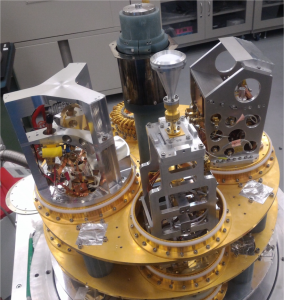
Receiver cartridges – 86, 230 and 345 GHz. Nāmakanui (“Big-Eyes”) is a heterodyne receiver unit making use of the ALMA “insert” concept for a dewar that can hold three single-receiver inserts. These inserts are used singly when observing (i.e. only one at a time). This configuration mirrors that of the Greenland Telescope (GLT) instrumentation (see here for link to the SPIE paper describing the GLT instrument).
Nāmakanui (an 86, 230 and 345 GHz instrument) was built by a team at ASIAA (Taiwan) and is on loan the to the JCMT as a spare for the GLT. Nāmakanui was delivered to the facility in August 2019 with installation at the telescope in September 2019. First light was achieved early October. Currently observatory staff are commissioning the `Ū`ū (230 GHz) receiver prior to working on the other inserts.
Receivers
The three heterodyne receiver inserts work at 86, 230 and 345 GHz. The inserts are named `Ala`ihi (“Squirrelfish”) 86GHz, `Ū`ū (“Soldierfish”) 230GHz, and `Āweoweo (“Big Eye”) 345GHz. The 86 GHz insert is a dual polarization, 1-sideband mixer. The 230 and 345 GHz inserts have dual polarization 2-sideband mixers, producing four Intermediate Frequencies (IFs) with bandwidths of 4 – 12 GHz each (although this may be restricted to 4 – 8 GHz initially). Aweoweo (345 GHz) will be capable of supporting IFs in the 5 – 9 GHz range. Please note that, at present, the ACSIS IF system only supports IFs of 4 – 7.3 GHz.
The 230 and 345 GHz mixers are identical to those used by ALMA. More technical details on the 230 GHz mixer are available here. The 230 GHz unit was produced by NRAO for ALMA and the 345 GHz unit was produced by IRAM for ALMA. The most recent public user information on these receivers is given in Sections 4.2.4 and 4.2.5 of the ALMA Technical Handbook. Due to each insert having a separate optical path (TMU position), only one receiver/frequency range can be used at any one time.
Note that special considerations must be taken into account when observing targets with a strong continuum such as the moon, the Sun, or planetary atmospheres.
References for Nāmakanui:
- Commissioning of Nāmakanui on the JCMT, Mizuno et al. 2020



